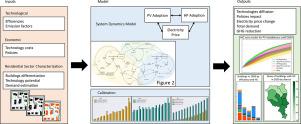模拟瑞士住宅建筑中光伏和热泵的共同采用动态:对政策和可持续发展目标的影响
IF 7.9
2区 工程技术
Q1 ENERGY & FUELS
引用次数: 0
摘要
瑞士能源系统正面临模式转变,努力实现温室气体净零排放,并逐步淘汰核电生产。这意味着瑞士的能源格局将发生重大变化,包括在住宅领域更多地采用可再生能源技术。为便于决策者做出明智的决策和规划,本研究引入了一个系统动力学模型,用于分析瑞士住宅建筑长期采用太阳能光伏(PV)和热泵(HP)技术的情况。与传统方法不同,该框架考虑了光伏和热泵技术应用之间的反馈回路和相关性,同时还考虑了建筑的异质性。通过情景分析,该模型评估了监管和金融政策干预对住宅能源系统转型的影响。结果凸显了政策措施对技术部署率、能源需求和温室气体排放的重大影响。结果表明,对现行政策和监管框架稍作调整,就可以安全地实现光伏发电的部署目标,但要使住宅部门完全脱碳,则必须进行强有力的调整。这项研究有助于加深我们对影响住宅能源转型的复杂动态的理解,并为支持有效能源战略的制定和实施提供了宝贵的见解。本文章由计算机程序翻译,如有差异,请以英文原文为准。

Modeling the co-adoption dynamics of PV and heat pumps in Swiss residential buildings: Implications for policy and sustainability goals
The Swiss energy system is facing a paradigm shift as it strives to achieve net-zero greenhouse gas emissions, as well as phase out nuclear electricity production. This entails significant changes in the country’s energy landscape, including increased adoption of renewable energy technologies in the residential sector. To facilitate informed decision-making and planning by policymakers, this study introduces a system-dynamics model for the long-term adoption of solar photovoltaic (PV) and heat pump (HP) technologies in Swiss residential buildings. Unlike conventional approaches, this framework considers the feedback loops and correlations between PV and HP adoption, while also accounting for building heterogeneity. Through scenario analyses, the model evaluates the impact of regulatory and financial policy interventions on the transition of the residential energy system. The results highlight the significant influence of policy measures on technology deployment rates, energy demand, and greenhouse gas emissions. They demonstrate that slight adjustments in current policy and regulatory framework could allow to safely reach PV deployment targets, but strong modifications are necessary to completely decarbonize the residential sector. This study contributes to advancing our understanding of the complex dynamics shaping residential energy transitions and offers valuable insights to support the formulation and implementation of effective energy strategies.
求助全文
通过发布文献求助,成功后即可免费获取论文全文。
去求助
来源期刊

Energy Strategy Reviews
Energy-Energy (miscellaneous)
CiteScore
12.80
自引率
4.90%
发文量
167
审稿时长
40 weeks
期刊介绍:
Energy Strategy Reviews is a gold open access journal that provides authoritative content on strategic decision-making and vision-sharing related to society''s energy needs.
Energy Strategy Reviews publishes:
• Analyses
• Methodologies
• Case Studies
• Reviews
And by invitation:
• Report Reviews
• Viewpoints
 求助内容:
求助内容: 应助结果提醒方式:
应助结果提醒方式:


